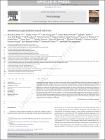| dc.identifier.citation | Da Mota, B., Fritsch, V., Varoquaux, G., Banaschewski, T., Barker, G.J., Bokde, A.L.W., Bromberg, U., Conrod, P., Gallinat, J., Garavan, H., Martinot, J.-L., Nees, F., Paus, T., Pausova, Z., Rietschel, M., Smolka, M.N., Ströhle, A., Frouin, V., Poline, J.-B., Thirion, B., Randomized parcellation based inference, NeuroImage, 89, 2014, 203-215 | en |
| dc.description.abstract | 29 Accepted 5 November 2013
30 Available online xxxx
3213
34 Keywords:
35 Group analysis
36 Parcellation
37 Reproducibility
38 Multiple comparisons
39 Permutations
54 53
55 Introduction
56 Analysis of brain images acquired on a group of subjects makes it
57 possible to draw inferences on regionally-specific anatomical properties
? Correspondingauthorsat:CEA,DSV,I2BM,Neurospinba?t145,91191Gif-Sur-Yvette, France.
E-mail addresses: benoit.da_mota@inria.fr (B. Da Mota), bertrand.thirion@inria.fr (B. Thirion).
1 These authors contributed equally to this work.
2 URL: http://www.imagen-europe.com
1053-8119/$ ? see front matter ? 2013 Elsevier Inc. All rights reserved. http://dx.doi.org/10.1016/j.neuroimage.2013.11.012
?2Q46
?2Q57
?article info
abstract
Neuroimaging group analyses are used to relate inter-subject signal differences observed in brain imaging with 40 behavioral or genetic variables and to assess risks factors of brain diseases. The lack of stability and of sensitivity 41 of current voxel-based analysis schemes may however lead to non-reproducible results. We introduce a new 42 approach to overcome the limitations of standard methods, in which active voxels are detected according to 43 a consensus on several random parcellations of the brain images, while a permutation test controls the false 44 positive risk. Both on synthetic and real data, this approach shows higher sensitivity, better accuracy and higher 45 reproducibilitythanstate-of-the-artmethods.Inaneuroimaging?geneticapplication,wefindthatitsucceedsin 46 detecting a significant association between a genetic variant next to the COMT gene and the BOLD signal in the 47 left thalamus for a functional Magnetic Resonance Imaging contrast associated with incorrect responses of the 48 subjects from a Stop Signal Task protocol. | en |




